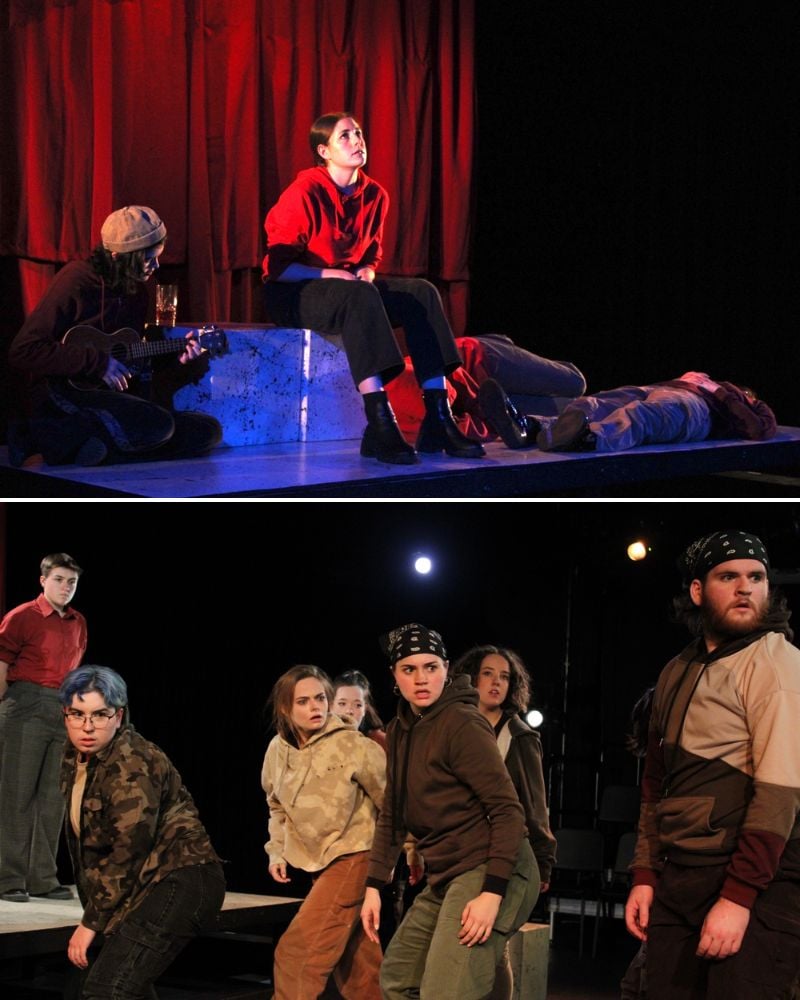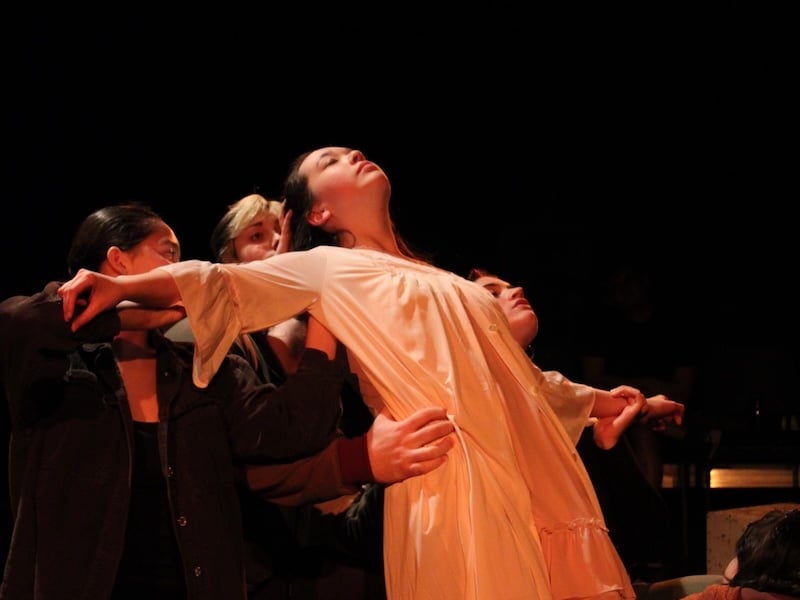In American University’s Capstone Production of Julius Caesar, the play begins before the audience realizes it. Before the lights dim and the audience chatter fades away, a soothsayer begins to crawl around the stage, whispering madly to themself, then darts away. It is only several moments after the soothsayer appears onstage, absorbed in their dark predictions, that the audience goes silent. This portent of doom transitions the audience into the world of 44 BCE Rome, where they — “Friends, Romans, Countrymen” — are then instructed by an announcement to silence their cellphones and enjoy the show.
The student-run production is the senior capstone project of seven graduating Theatre and Musical Theatre students at American University. In this production, they worked alongside 15 other students in the cast, crew, and directing staff to bring Shakespeare’s political tragedy to life.
Directed by Elena Zimmerman and produced and choreographed by Lila-Rose Roberts, Julius Caesar depicts the assassination of Julius Caesar (Vish Shukla), a pivotal moment in the history of Rome. Both this production and Shakespeare’s original text choose not to emphasize the act of assassination — in this production, Caesar dies almost as quickly as the first knife appears — but instead focuses on the conspiracy leading up to it and the civil war that follows.

Producing a work of Shakespeare is a staple of theater, but also a formidable undertaking, setting thespians down the path of interpreting lengthy scripts and complex language. The student actors in American University’s Theatre Department proved they were up for the task. Clearly exhibiting they understood the language of Shakespeare, they spoke the lines naturally, as if it were their own lived language.
Standing in for Katie Zimmerman, who usually plays the role of Cassius, director Elena Zimmerman’s portrayal of the assassination plot’s mastermind was especially impressive for an actor who took on a role she had not prepared for. Zimmerman rarely stands still on stage for long. Instead, she prowls the set and eyes her fellow Romans, evidently absorbed in the plots always going on in the back of Cassius’ mind.
Rieke expertly portrays Brutus’ uncertainty and initial unwillingness to join the conspiracy. In nearly every scene leading up to the pivotal moment, her face is twisted by concerned expressions as Brutus searches Caesar’s face and actions for a reason not to carry out the bloody task of betrayal.
While Caesar’s most power-hungry moments occur off-stage, Shukla does an excellent job of portraying Caesar’s desire for power and waning ability to hold it back. Shukla speaks in a boastful baritone and greedily drinks in the attention of the Roman public, but also displays the Roman General’s vulnerability when he almost acquiesces to his wife Calpurnia’s (Sedona Salb) pleas to stay home on the Ides of March.
Salb’s performance as Calpurnia is notable as well. Her fear-laced portrayal of Calpurnia as she tells her husband about her nightmares of his assassination underlines the later impact of his death and grounds the play’s political conspiracy in its human impacts.

In a compelling addition to the story told on stage, at various points in the show the production inserted dialogue-less scenes centered around sound and movement. In one, the cast uses fluid, dancelike movements, fluttering blue ribbons tied to their wrists, and a combination of claps and snaps to create the storm that portends Caesar’s death. In another, Calpurnia’s nightmare about Caesar’s fate is brought to life by Calpurnia’s dreamlike trance and the first elegant, then vicious in-unison movements of the ensemble cast. The impact of Marc Antony’s rousing speech to the Roman masses at Caesar’s funeral is similarly amplified by the choreography and sound design. The ensemble that comprises the Roman onlookers moves and speaks in unison, evoking a larger group and reflecting how mobs can be stirred into collective action.
These were the show’s most captivating moments. By incorporating other performance disciplines — song and movement — into the play, the performers enhanced the scenes and displayed the talents they cultivated in American University’s Theatre Department.
Another inspired design choice was the use of red as the defining motif of the production. Nearly every character’s costume, save for the servants and commoners, contained an element of red. The Roman Senators wore red dress shirts, sweater vests, or blazers. Caesar wore a red suit trimmed in gold — a nod, perhaps, to his kingly ambitions. Brutus, decked out almost entirely in red, wore a smart red sleeveless pantsuit, occasionally accompanied by a brown blazer. If red is to denote Rome, Brutus’ dedication, exhibited through the color he wears from torso to ankle, is reemphasized through this costuming choice.
Notably, the female characters dress in colors outside this crimson colorscape: Calpurnia’s costume contains elements of black, white, and pink. Portia, Brutus’ wife, dons blue. Even the soothsayer is draped in a violet cape. The marginalization of these women from the plots of the men in their lives is reflected by the contrast in their color palettes. They do not exist in the red-colored world of politics. Their deviance from this color standard also reflects, tragically, how the perspectives and advice they offer to the men ultimately go ignored, leading to the play’s tragic end.
These strong costume choices, led by Co-Costume Designers Eva Baker and Olivia Levin, wove a thematic thread through the production and exhibited the creativity of the student production team.
The title Julius Caesar may be in reference to one man, and the main thrust of the plot may be driven by the actions of a few others, but American University’s production is truly an ensemble production. Reflecting the work of the senior Capstone Class, various theatrical disciplines — including choreography, sound design, and costuming — were able to shine. The utilization of the ensemble cast as a group that moves in unison also places an emphasis on the collective and ties into the themes of the play: as democracy is threatened, the masses must remember and take charge of their power, rather than allow themselves to be swayed by propaganda and turned into a political tool.
Running Time: Two hours, including one 10-minute intermission.
Julius Caesar plays through March 22, 2025, presented by spring 2025 Capstone class of the Theatre/Musical Theatre majors at American University. performing in the Studio Theatre at the Katzen Arts Center, 4400 Massachusetts Ave NW. For tickets (free), call (202) 885-3634 or order online.
Julius Caesar
By William Shakespeare
CAST
Brutus: Lucille Rieke
Cassius: Katie Zimmerman*
Caesar, Ghost, Pindarus: Vish Shukla*
Flavius, Cinna, Messala, Plebeian 5, Lepidus, Popilius: Anna Palumbo
Casca, Artemidorus 5: Daniel Zavilowitz
Antony, Artemidorus 4: Molly Gannon
Calpurnia, Titinius: Sedona Salb
Portia, Octavius: Morgan Kullen
Trebonius, Lucilius, Plebeian 2, Caesar/Antony/Octavius’ Servant, Cobbler, Cicero: Eva Baker*
Lucius, Artemidorus 2: Isabel Manning
Marullus, Metellus, Soothsayer, Cato, Artemidorus 1, Plebeian 1, Soldier 1, Volumnius, Varro: Liv DeLorenzo
Decius Brutus, Clitus, Artemidorus 3, Plebeian 3, Soldier 3, Carpenter, Claudius: Ollie Hunter
Soldier 5: Quinn Laubach
*Denotes a Capstone Student
ARTISTIC AND CREATIVE TEAM
Director: Elena Zimmerman*
Producer, Choreographer: Lila-Rose Roberts*
Assistant Choreographer: Isabel Manning
Assistant Choreographer: Molly Gannon
Stage Manager: Alyssa Nolan*
Assistant Stage Manager: Kate Grimble
Scenic Designer, Assistant Stage Manager: Quinn Laubach
Music Director: Connor Reagan
Sound Designer: Ian Dever
Lighting Designer: Jason Zuckerman*
Properties Designer: Maison Gamble
Co-Costume Designer: Eva Baker*
Co-Costume Designer: Olivia Levin
Dramaturg: Megan Kempton
Intimacy Choreographer: Sedona Salb
Fight Choreographer: Vish Shukla*
*Denotes a Capstone Student



